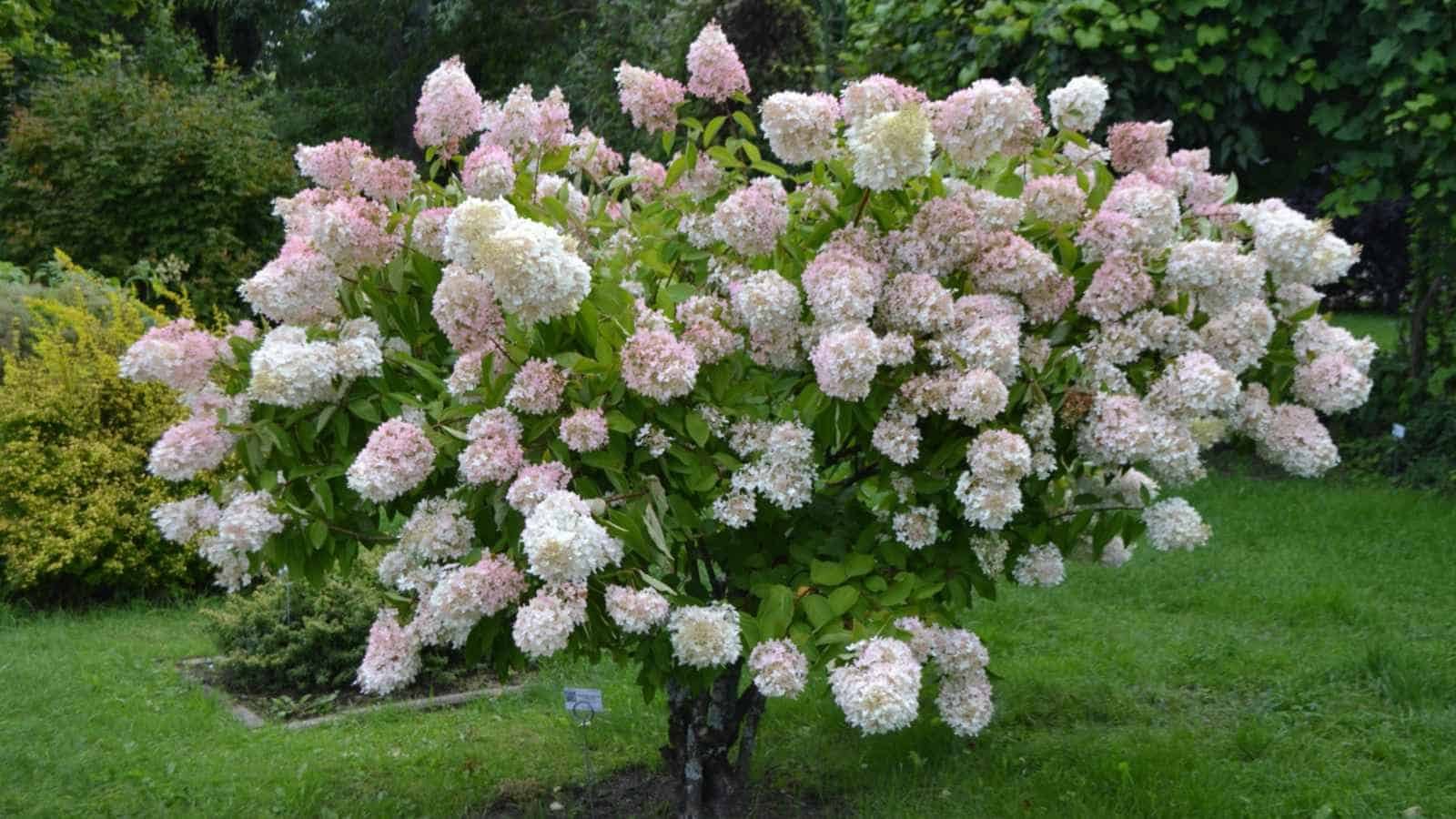Introduction
Hydrangea trees are beloved by garden enthusiasts for their stunning blooms and ability to add a touch of elegance to any landscape. However, like any other plant, hydrangea trees are susceptible to diseases that can affect their overall health and beauty. This article will discuss the common diseases can affect hydrangea trees, with a specific focus on the Limelight hydrangea variety. We will explore the symptoms, prevention methods, and treatment options for these diseases, as well as provide some general care tips for hydrangea trees.
About Hydrangea Trees
Hydrangea trees, scientifically known as Hydrangea paniculata, are deciduous shrubs that can grow into tree-like forms. Native to Asia, these trees are popular for their large, showy flower clusters that range in color from white, pink, to even lime green. The Limelight hydrangea, a cultivar of Hydrangea paniculata, has gained considerable popularity due to its unique cone-shaped flower heads and vigorous growth.
Limelight Hydrangea: Overview
The Limelight hydrangea is a beautiful variety known for its eye-catching lime-green blooms that turn creamy-white as they mature. Its straight stems and dense foliage make it an ideal choice for hedges or standalone specimens in a garden. This particular hydrangea variety is highly adaptable and can thrive in various soil types and climates.
Limelight Hydrangea Care
Proper care is essential for the healthy growth of Limelight hydrangeas. These plants prefer full sun to partial shade and thrive in moist, well-drained soil. It is recommended to water them regularly, especially during hot and dry periods. Mulching around the base of the tree helps retain moisture and regulate soil temperature. Additionally, providing adequate spacing between plants promotes air circulation and prevents the spread of diseases.
Pruning Limelight Hydrangea
Pruning is a crucial aspect of Limelight hydrangea care. It is best to prune these trees in late winter or early spring while they are still dormant. The purpose of pruning is to remove dead or damaged branches and encourage new growth. Cutting back about one-third of the old branches helps maintain the tree’s shape and promotes better blooming.
Size and Varieties of Limelight Hydrangea
Limelight hydrangeas are relatively large and can reach a height and spread of 6 to 8 feet when fully grown. However, there are compact varieties available, such as Little Lime and Bobo, which are ideal for smaller gardens or container planting.
Bloom Time and Spacing for Limelight Hydrangea
The Limelight hydrangea blooms from mid-summer through early fall, bringing a vibrant burst of color to any garden. When planting these trees, leave ample space between each plant to allow for proper air circulation and avoid overcrowding.
Fertilizing Limelight Hydrangea
Regular fertilization helps keep Limelight hydrangeas healthy and promotes robust growth. Applying a balanced slow-release fertilizer in early spring and again in mid-summer is recommended. Avoid using high-nitrogen fertilizers, as they can lead to excessive foliage growth at the expense of flower production.
Diseases Affecting Limelight Hydrangea
Unfortunately, Limelight hydrangeas are not immune to diseases that can detrimentally affect their health and beauty. The most common diseases that can afflict these trees include powdery mildew, leaf spot, root rot, and bacterial wilt.
Companion Plants for Limelight Hydrangea
To enhance the visual appeal of your garden, consider companion planting with other attractive and complementary plants. Some excellent choices include hostas, astilbes, ferns, and ornamental grasses.
Sun or Shade: Growing Limelight Hydrangea
Limelight hydrangeas thrive in a variety of light conditions, ranging from full sun to partial shade. However, they tend to produce the best blooms when exposed to at least six hours of direct sunlight each day.
Watering Requirements for Limelight Hydrangea
Proper watering is critical for the health and vitality of Limelight hydrangea trees. While they tolerate drought once established, regular watering, especially during dry spells, is necessary for optimal growth. Be mindful not to overwater, as this can lead to root rot and other diseases.
Landscape Ideas for Limelight Hydrangea
Limelight hydrangeas are versatile and can be used in various landscaping designs. They work well as focal points, hedges, or border plants. Their stunning blooms also make them perfect for cut flower arrangements to add a touch of elegance indoors.
Planting Limelight Hydrangea in Containers
For those with limited garden space or wanting more mobility with their hydrangeas, planting Limelight hydrangeas in containers is a great option. Ensure that the container has proper drainage, and use a high-quality potting mix formulated for container gardening. Regular watering and fertilization are crucial to maintain the health of potted hydrangeas.
Troubleshooting: Limelight Hydrangea Not Blooming
If your Limelight hydrangea is not blooming, there could be several reasons for this. Lack of sunlight, improper pruning, excessive nitrogen fertilization, or disease infestation could all be contributing factors. Assessing these aspects and making appropriate adjustments will help encourage blooming.
Hydrangea Trees and Common Diseases
Hydrangea trees, including the Limelight variety, are susceptible to various diseases caused by fungi, bacteria, and environmental factors. Identifying these diseases early on is crucial to prevent further deterioration of tree health.
Preventing Diseases in Hydrangea Trees
Maintaining good cultural practices is the first line of defense against diseases in hydrangea trees. Providing proper watering, avoiding overhead irrigation, practicing proper hygiene, and ensuring adequate air circulation are effective preventative measures.
Controlling and Managing Hydrangea Tree Diseases
Treatment options for hydrangea tree diseases depend on the specific ailment but often involve pruning diseased branches, improving soil drainage, using fungicides or bactericides, and adopting integrated pest management techniques.
Protecting Hydrangea Trees from Diseases
Protecting hydrangea trees from diseases is a continuous effort that involves regular inspection, prompt action at the first sign of trouble, and maintaining optimal growing conditions. Monitoring the overall health of your tree and taking immediate action will go a long way in warding off diseases.
Identifying Symptoms of Diseases in Hydrangea Trees
Early detection of diseases in hydrangea trees is crucial for effective treatment. Common symptoms include wilting leaves, discoloration, spots or blotches on foliage, stunted growth, and abnormal blooming patterns.
Common Ailments of Hydrangea Trees
Hydrangea trees are prone to various ailments caused by fungi and bacteria. Some of the most common ones include powdery mildew, gray mold, leaf spot, root rot, and bacterial wilt.
Disease-Resistant Hydrangea Tree Varieties
There are several hydrangea varieties that exhibit resistance to certain diseases. When selecting hydrangea trees for your garden, consider disease-resistant cultivars, such as ‘Pinky Winky,’ ‘Little Lime,’ and ‘Quickfire.’
Treating Diseases in Hydrangea Trees
Treating diseases in hydrangea trees often involves targeted approaches such as pruning affected areas, improving cultural practices, and applying appropriate fungicides or bactericides. Consult with a horticulturist or arborist for specific treatment recommendations.
Diagnosing Diseases in Hydrangea Trees
Accurate diagnosis is vital for effective disease management in hydrangea trees. If you are unsure about the cause of symptoms, consider consulting a professional who can identify the problem and recommend appropriate treatments.
Common Fungal Diseases in Hydrangea Trees
Fungal diseases can wreak havoc on hydrangea trees. Common fungal infections include powdery mildew, gray mold, and various leaf spot diseases. Prompt action and proper identification are crucial for successful control.

